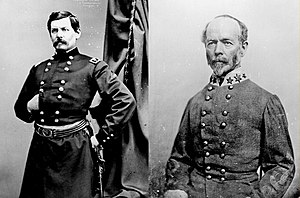Peninsula Campaign
| Peninsula Campaign | |||||||
|---|---|---|---|---|---|---|---|
| Part of the American Civil War | |||||||
 George B. McClellan and Joseph E. Johnston, respective commanders of the Union and Confederate armies in the Peninsula Campaign. |
|||||||
|
|||||||
| Belligerents | |||||||
|
|
|
||||||
| Commanders and leaders | |||||||
| George B. McClellan |
Joseph E. Johnston Gustavus Woodson Smith Robert E. Lee John B. Magruder |
||||||
| Units involved | |||||||
| Army of the Potomac | Army of Northern Virginia | ||||||
| Strength | |||||||
|
50-100,000 (estimated) | ||||||
| Casualties and losses | |||||||
| 26-27,000 (estimated) | 28-29,000 (estimated) | ||||||
The Peninsula Campaign (also known as the Peninsular Campaign) of the American Civil War was a major Union operation launched in southeastern Virginia from March through July 1862, the first large-scale offensive in the Eastern Theater. The operation, commanded by Maj. Gen. George B. McClellan, was an amphibious turning movement against the Confederate States Army in Northern Virginia, intended to capture the Confederate capital of Richmond. McClellan was initially successful against the equally cautious General Joseph E. Johnston, but the emergence of the aggressive General Robert E. Lee turned the subsequent Seven Days Battles into a humiliating Union defeat.
McClellan landed his army at Fort Monroe and moved northwest, up the Virginia Peninsula. Confederate Brig. Gen. John B. Magruder's defensive position on the Warwick Line caught McClellan by surprise. His hopes for a quick advance foiled, McClellan ordered his army to prepare for a siege of Yorktown. Just before the siege preparations were completed, the Confederates, now under the direct command of Johnston, began a withdrawal toward Richmond. The first heavy fighting of the campaign occurred in the Battle of Williamsburg, in which the Union troops managed some tactical victories, but the Confederates continued their withdrawal. An amphibious flanking movement to Eltham's Landing was ineffective in cutting off the Confederate retreat. In the Battle of Drewry's Bluff, an attempt by the U.S. Navy to reach Richmond by way of the James River was repulsed.
...
Wikipedia
